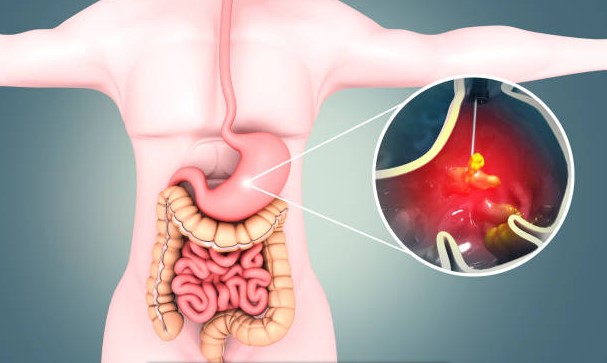Acid-related ulcers.
Today, the majority of people in the motherland suffer from acidity or gastrointestinal issues. This is because the majority of us have formed eating habits that cause constant stomach acidity. Many individuals mistake the pain of a heart attack for an acidity problem since this degree of acidity is so high and normal. Long-term acidity problems can eventually develop into fatally damaging ulcers. The article you’re reading today will explain how acidity causes ulcers and what signs to look out for.
Why does an ulcer occur?
The definition of an ulcer is “wound.” The main cause of ulcers is damage to the stomach and small intestine lining caused by the digestive system’s acid. These wounds could bleed as well. There is a sort of mucus that lines the walls of the digestive tract. Acid is shielded from the digestive tract by this mucosal layer. However, ulcers develop when the acid level is high or the mucous layer is thin. There are furthermore some usual causes. For instance,
- An infection with Helicobacter pylori harms the digestive system’s mucous layer and results in ulcers.
- The mucous layer of the digestive tract is harmed by the frequent use of NSAIDs and painkillers like aspirin, ibuprofen, naproxen, etc. without a prescription or doctor’s guidance. For trivial issues, many people take excessive amounts of these medications. which is completely untrue.
- In addition, even when steroid medications are taken irregularly, the mucous layer of the stomach is harmed.
- Regular smoking results in stomach ulcers.
- Alcohol consumption might contribute to ulcer issues. Because alcohol causes the stomach’s mucous layer to dissolve and creates too much acid.
- Excessive stress causes an increase in acidity, which eventually leads to ulcers.
- Consuming salty and fatty foods in excess makes you more acidic.
Ulcers can also be brought on by other factors besides those mentioned above. These elements make ulcers more likely to develop and more challenging to heal. If these symptoms persist for a while, see a doctor right away.
Variety of ulcers
There are primarily two types of acidic ulcers.
Gastric ulcer
A gastric ulcer usually develops on the stomach’s inside.
Duodenal Ulcer
This kind of ulcer develops in the upper small intestine.
If you notice any signs, you’ll be able to tell if you have ulcers.
- In the upper area of the stomach, there is pain or a burning sensation
- Constantly feeling full, bloated, or bloating that is excessive
- Greasy food indigestion
- Heartburn nausea
- Stools in a dark color
- Blood in the vomit (if the ulcer condition gets out of hand)
- Reduced appetite
- Breathlessness weight loss
How can you tell?
Doctors do a physical examination in addition to a few clinical diagnostic procedures to identify ulcers. For instance,
Breath test:
A breath test is used to find out if Helicobacter pylori bacteria are present.
Endoscopy:
During this operation, the doctor inserts a camera into the head of a hollow tube and uses the mouth and throat to view the whole digestive system. If an ulcer is discovered, tissue from the ulcer is removed from the biopsy, and the following course of therapy is decided.
Barium swallow X-Ray
An imaging procedure known as a barium swallow involves mixing a chemical compound called barium with water. On X-rays, the fluid may be seen clearly as it travels through the digestive tract, which aids in diagnosis.
Treatment approach
Treatment for ulcers is typically based on their origin. Therefore, the ulcer’s source must be identified before therapy can begin. Three phases make up the bulk of this treatment.
- If Helicobacter pylori are present, it should be eliminated using medication.
- Reducing or stopping the use of steroid or irregular pain medications is advised.
- According to a doctor’s recommendation, medication should be taken for treatment.
Using specific drugs to lower excessive acid production is another way to treat ulcers. For instance, using medications like antacids might lessen the impact of stomach acid. Once more, several medications can protect the digestive system’s mucus layer.
What potential issues could arise?
Several complications may arise if the ulcer is not treated correctly and promptly. For instance,
- The likelihood of bleeding from the digestive tract’s walls increases as a result of ulceration. Anything from anemia to vomiting blood or having black stools can happen as a result.
- A life-threatening condition may arise if the ulceration is severe enough to perforate the digestive system’s walls. The medical term for this is perforation.
- If there is an ulcer in the digestive tract, food cannot flow through freely. As a result, after a small meal, the stomach either feels full or empty. nausea and loss of weight.
- Research has indicated that having Helicobacter pylori increases the risk of developing stomach cancer.
Conclusion
The first sign of an ulcer is acidity. You must therefore take precautions in advance if there is acidity. Change your food and lifestyle habits to live a more controlled existence. A doctor should be seen if the acidity is causing additional difficulty.
Instagram Twitter Facebook LinkedIn Quora Google News
Our Other Engagements:









